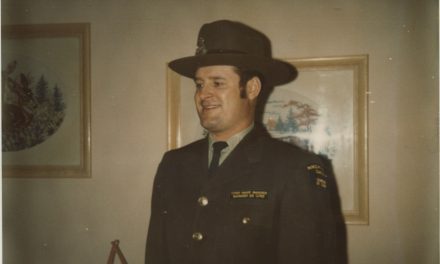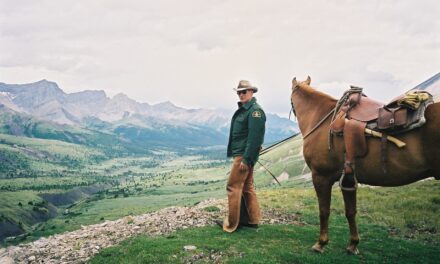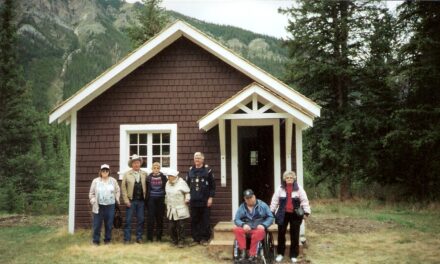MH: Do you have any lasting memories as a Warden? 5350:
CW: I was thinking about that the other day because Karsten Heuer sent me a picture of the bison in the Scotch Camp meadow and we had spent an awful lot of good times sitting on that porch at Scotch cabin. In the old days, we used to sight-in our rifles there, and sit in the chair and shoot tin cans in the meadow right off the porch. But now-a-days you’d disturb a bunch of bison. It’s nice to see that the bison are back there now because we used to talk about that in the old days, how nice it would be to see them back there. It was neat to see that picture the other day.
5438: We also had many many great days at the YaHa TInda Ranch. For about 15 years I was the science advisor to the ranch manager out there so I would be out there a few days a month helping out where you could in terms of ecology– sometimes maybe giving more bad advice than good. I spent a lot of great times with Johnny and Marie Nylund on the ranch house deck and then Rick and Jean Smith later on. Just a lot of great conversations. There are still ongoing research programs there. They converted one of the houses into a research house. The University of Montana and University of Alberta have been working out of there for about 20 years. The ranch managers have provided an amazing environment for the younger people to do research, and see how a sustainable ranch is run. Rick and Jean, Johnny and Marie, Rob Jennings, Tom Mackenzie do an amazing job in training the parks staff and horses to work safely work together. I think the horse program is one reason why Banff had so much luck with bison restoration. The YaHa Tinda horses sometimes seem semi-wild at the ranch as they run off the bears and the wolves!
5556: We grew up with horses at Sunshine but I did a lot more walking than riding because I’d end up going somewhere and forgetting to tie the horse up right and even if we did, we’d lose them so I walked back from many many places during my Sunshine trips. In fact, I think every good Sunshine horse trip we had, finished with a long walk home… even the ones my Dad took me out on. The worst walk home was from Assiniboine when I was about 10 years old. We got there and we put our horses on the far side of the drift fence at Sunburst Lake. We thought they would stay there and of course they didn’t. They buggered off and headed down the Mitchel, then Simpson River not to be seen for two weeks, so we had to walk out of there in our cowboy boots. That was a long haul! We were staying at Lizzie Rummel’s that time, but when we lost the horses, we had to arrange food supplies with the Stroms over at Assiniboine Lodge. I really didn’t want to go over there because the cabin us kids had burnt down in Sundance Canyon near Banff the previous year was Strom’s base cabin. So I had to go over there and apologize profusely to Siri Strom and Al Johnson for burning down their cabin. We then had to negotiate to get enough food and get out of there. We went out via 10-mile lodge and used Strom’s cabins because it was too far to walk all the way back to Sunshine. Anyways, I learned what goes around comes around. Be careful who’s cabin you burn down, you might have to meet them the next year.
MH: Any other stories?
MH: Do you ever miss being a Warden? 5740:
CW: Yeah it’s kind of too bad the way it worked out. The first two years after I retired, Bob Haney and I volunteered to work with Chief Park Warden Ian Syme doing public relations backcountry trips for the Bison Restoration Project… sort of easing out of being a warden. But I guess Parks realized that there were so many of us who retired over the course of about five years (about 50 of us) and they couldn’t keep allowing everybody to come back on volunteer programs or there wouldn’t be any horses or cabins for the workers. They had to cut the program volunteer program down… so I really miss that but it made it fun those first two years after retiring. We took folks out from Sundre and other places, just to see where the bison were going to go. One of these days soon I hope we get another horse backcountry trip in. We’re owed one…maybe one of these days.
5900: When I retired, we were locked up for bison restoration in Parks by various political constraints with the Alberta Government. But it was possible that if I left Parks and started to work with Harvey Locke and Marie Marchand from the Luxton Foundation, and then Bob Haney and a few other people we might get critical mass to get the thing done. We knew we had good support within Parks Canada, especially from Banff’s Supt. Kevin Van Tighem. That became a big emphasis for a couple of years. We got a lot of help from Michale Lang from the Whyte Museum and a bunch of other folks. Marie Eve Marchand took over the program and started “Bison Belong” which was a real citizens movement and she drummed up tons of support. When it was all said and done, she had 15,000 or 20,000 people who were avid bison restoration supporters for Banff, and sending in postcards to the Minister. She had got together an army of people to support “bringing back the buffalo”, and it was fun to see how that made it happen. Parks then hired Karsten Heuer to actually do the on-the-ground restoration, and that was satisfying because he had worked with the Ecosystem shop over two decades earlier on restoring wildlife corridors in the park.
MH: Do you have any photos of yourself as a warden that you would like to donate? Artifacts? 1:00:00:
CW: Oh yeah, we have dozens of those! Lots of pictures of us burning something down but the ones of the first burn, the Strom cabin, are with the RCMP! In terms of artifacts, all my old stuff will go to the Whyte Museum and all the stuff I’m working on with historical distribution of wildlife based on early journals, so I have a database that’s 20,000 journal days of early explorers and what they saw every day so all those databases will go to the Whyte. They’ll be posted on their website eventually.
MH: What year did you retire? 1:01:25:
CW: November 2009
MH: What do you enjoy doing in retirement? 1:01:33:
CW: I never really retired. My wife Johanne manages our bank balance and the holiday schedule. When I left parks I was urged to go straight into the Bison Project and I also had a contract right away with Norquay Ski Hill. Parks Canada had been working on a way for the hill to get a summer use plan and a modified long range Ski Area Plan so I went to work for them the next year after I left, and then I went to Lake Louise Ski Hill to work with Dave Day on their long range plan. I guess I have stayed with the ski area planning part of the job. Meetings are about the same, we just sit on different sides of the other side of the table. You talk about the same things; everybody wants pretty much the same things. Most folks want to be able to ski but they also want to be able to maintain the park in good shape. Then about 2015 Banff decided they wanted to propose a model of having a few hundred bison, but that certainly wasn’t what all the earlier research on bison abundance indicated. Researchers I worked with in the ‘90s thought the Banff area probably never had more than 100 bison. As a result, I ended up having to go back to work and disentangle what had happened with bison all along the eastern slopes and why a model of 500 bison in Banff would be ridiculous. So now I’ve been working on for four years, right to down to Mexico and see how many bison were in the mountains historically and why were there so few. But that’s been fun because it allows us to travel a lot in the United States and one of the trips we did to see a lot of the country was to bike the Great Divide Bike Trail. A bunch of us Canmorans biked from Banff to Mexico over five years. About 700 miles per year biking right along the edge of bison range is where that trail goes, so all the way you could wonder why in the past so many bison were to the east of us on the plains and not so many to the west. I still have lots of field work to do down in the States and I still teach Fire-Management courses. I started teaching in Tucson, Arizona in 1993 at their advanced Fire Management Course (usually for two weeks every year) and I’ve done that for 30 years. Ian Pengelly and Alan Westhaver also worked on those courses for many years. It’s neat when you both get to spend a lot of time-sharing Parks Canada ideas with folks from the States.
MH: Is there anything I haven’t asked you that you think I should know about the Warden Service? 1:04:14:
CW: I think we covered a ton of ground in an hour and a bit.
MH: Anyone else to interview?
CW: You’ll have to get ahold of Tom Hurd and Ian Pengelly and my brother Brad White. Hopefully most of what I’ve said is semi-true.
MH: Any final comments?
CW: The other thing we can start to look at here is just doing Podcasts of the interview rather than transcribing them, which is the most difficult part of the interview. There’s probably enough storage out there now a day so maybe we should look at doing that. I think eventually we will have to go that way because it gives you a better flavor for the personality, it is easier to do. It would probably change your interview style a bit. Maybe the next round we have will be the verbal one. The nice thing with the typed transcripts is you can search by word, but the days of somebody reading an interview are quickly passing. Current generation is more into listening to podcasts rather than reading an interview. I’ll send out an email to the committee and go from there. You could send the podcast to the interviewee and edit out what he/she doesn’t want.
Interviewer: Monique Hunkeler
Monique Hunkeler worked with Parks Canada as Secretary to Banff National Park Finance Manager. She moved to Dispatcher for the Banff Park Warden Service and later worked within Banff National Park and Town of Banff’s IT departments. She is experienced with the interviewing, transcription and archiving process for the Park Warden Service Alumni Society oral history project.



